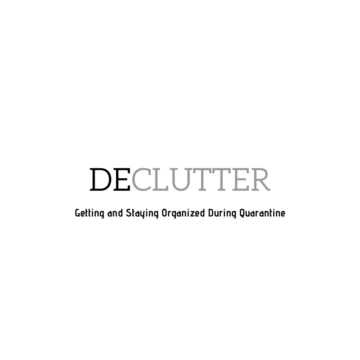
At this point, you’ve probably been home for about a week. You might be the kind of person who has managed to stay organized through the insanity of the past two weeks, through moving, quarantine, campus closures, and life changes, but for the majority of us, organization can be a struggle. If you’re surrounded by clutter, there are studies that show it can negatively affect both your mental health, and your mood. Look around you right now. Is your bedroom cluttered? Are you surrounded by things you don’t use and don’t need? Does your space “spark joy?” If it doesn’t, you might want to take some time and create a space with less anxiety and more mindfulness: a space that is both functional and beautiful. Does that sound impossible? Let’s talk about why it’s important, and some simple steps you can take to get and stay organized.
Why Declutter and Clean?
There are many benefits to an organized and decluttered space. A thorough article from Psychology Today discusses a myriad of the studies done on the effects of a messy home. One of these effects is that working in a cluttered environment is proven to make it more difficult to focus on the task at hand. Maryville Student Mackenzie Steiner, a Speech Therapy major, agreed. “Whenever I start to feel stressed and overwhelmed with my workload, I always like to clean my room because it gives me less to worry about. If I can organize what I see around me, it makes it easier to handle the various things in my mind like due dates, projects, and tests.” Mary Boser, a Communications major, said “Being organized puts me in a better headspace to be productive. When I can easily find what I need and don’t waste time looking for things, like files on my computer, it makes working easier.”
A Game Plan
So where do you start? If you’re overwhelmed by how much you have to do, start with these simple steps to start to make a difference. The three steps to an organized and clean space are Sort, Purge, and Organize.
1. Sort.
Ashley from creativelyneat.com, a popular organizing and decluttering company, uses this method with her clients: people like Gabby Hanna and Michelle Khare. Instead of trying to organize everything at once, sort by “sub-categories” like Marie Kondo does on her Netflix show, into clothing, books, papers, Komono (miscellaneous), and mementos or sentimental items. By taking on one kind of item at a time, it is easier to declutter and clean effectively.
2. Purge
This is the difficult part for many of us. Getting rid of things is hard, especially when we have had them a long while. In this stage, it is important to keep things that we actively use, and things that bring us joy. The Minimalists have a simple rule for getting rid of things that you don’t need: If you haven’t used it in 90 days, and if you won’t use it in the next 90 days, let it go.
3. Organize
Once things are sorted and you’re able to let go of the things that no longer have a place in your life, then the fun starts! When organizing, don’t worry about the aesthetics of where things go, or try to make your space look like a Pinterest board. What kind of system will work best for you? What is actually going to add value to your life and make your space peaceful? You get to choose!
How to STAY Organized.
A common problem that many students have is staying organized. It can be easy to spend an entire afternoon cleaning, only to have the house be cluttered and messy again within a week. Here are a few tips to stay organized.
1. If it takes less than 5 minutes, put it away immediately.
It takes 20-30 seconds to fold and put away a piece of clothing. Maybe 1 minute to make your bed. Get in the habit of taking the extra minute to return your space to tidy whenever you have the chance. It’s a lot easier to do this than to take 6 hours and an entire Saturday afternoon to tidy your space!
2. Start a system
Mess happens, and that’s okay. If you’re overwhelmed with clutter and don’t have time to tidy right away, create a system to handle clutter quickly, and then come back to it. “I know I’m going to be messy, so I have a designated junk drawer,” Mary Boser says. “I can just toss things in the drawer to avoid feeling like my space is a mess, and then I’ll go and clean out the drawer when I have the time.” A drawer, a basket or a bin by the doorway of your space, or even a closet would work.
3. Function Over Form.
When in the “organization” phase above, implement an organization system that will best work for you. There are many visually beautiful and “aesthetic” systems on Instagram and Pinterest, but if the system is not easy to use for you personally, you will not use it. Make each step as easy as possible for yourself, and experiment with an organizational system that will be easy for you to use.
When your space is organized and decluttered, it can improve your mental health, your mood, and your productivity. Hopefully these simple steps can help you during this time. For more resources, check out theminimalists.com, creativelyneat.com, and the Netflix series, Tidying Up with Marie Kondo.




